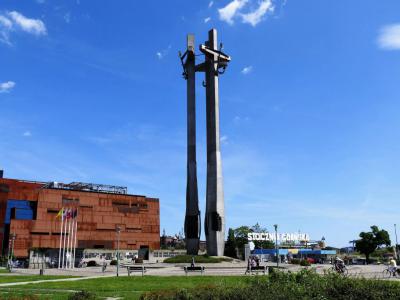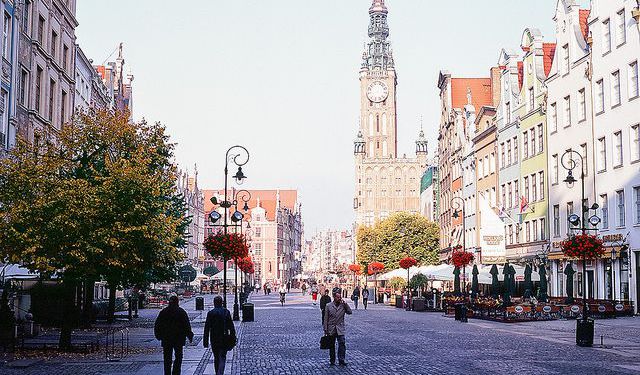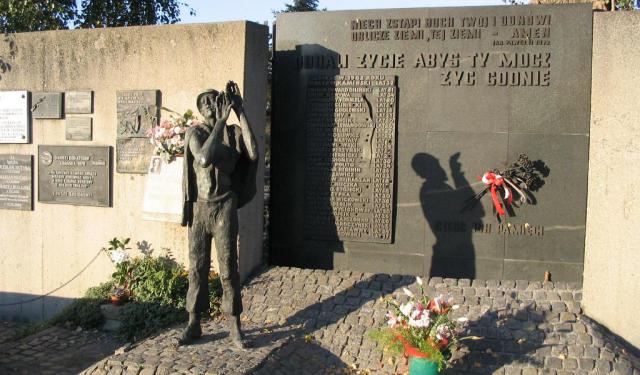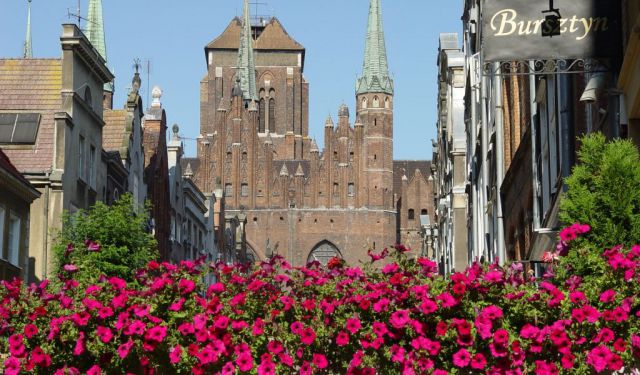Monument to the Fallen Shipyard Workers, Gdansk
In Gdansk, the main feature of Solidarity Square is the towering 42-meter-tall Monument to the Fallen Shipyard Workers of 1970. This monument is a tribute to the 42 or more individuals who lost their lives during the December 1970 disturbances in the Coastal Cities. These protests were triggered by sudden increases in the prices of food and other basic goods and were harshly suppressed by the Polish People's Army and the Citizen's Militia, leading to over 40 deaths and more than 1,000 injuries.
Unveiled on December 16, 1980, near the entrance to the then Lenin Shipyard in Gdańsk, the Monument was established following the Gdańsk Agreement. It holds the distinction of being the first memorial for victims of communist rule built in a communist nation, a feat made possible only after the Agreement was signed. Financial support for its construction came from the striking workers, residents, and contributors from across Poland.
The government tried to delay and rename the monument to honor fallen policemen, but faced resistance. The Monument Committee overcame obstacles and unveiled it on the tenth anniversary of the 1970 events with a piece by Polish composer and conductor Krzysztof Penderecki commissioned by Lech Wałęsa.
The monument features three crosses, each 42 meters tall and weighing 36 tons, with a two-ton anchor hanging from each. At its base, some reliefs depict the lives of shipyard workers. It also includes a quote from Psalm 29 and a part of Czesław Miłosz's poem "Who You Wronged."
Unveiled on December 16, 1980, near the entrance to the then Lenin Shipyard in Gdańsk, the Monument was established following the Gdańsk Agreement. It holds the distinction of being the first memorial for victims of communist rule built in a communist nation, a feat made possible only after the Agreement was signed. Financial support for its construction came from the striking workers, residents, and contributors from across Poland.
The government tried to delay and rename the monument to honor fallen policemen, but faced resistance. The Monument Committee overcame obstacles and unveiled it on the tenth anniversary of the 1970 events with a piece by Polish composer and conductor Krzysztof Penderecki commissioned by Lech Wałęsa.
The monument features three crosses, each 42 meters tall and weighing 36 tons, with a two-ton anchor hanging from each. At its base, some reliefs depict the lives of shipyard workers. It also includes a quote from Psalm 29 and a part of Czesław Miłosz's poem "Who You Wronged."
Want to visit this sight? Check out these Self-Guided Walking Tours in Gdansk. Alternatively, you can download the mobile app "GPSmyCity: Walks in 1K+ Cities" from Apple App Store or Google Play Store. The app turns your mobile device to a personal tour guide and it works offline, so no data plan is needed when traveling abroad.
Monument to the Fallen Shipyard Workers on Map
Sight Name: Monument to the Fallen Shipyard Workers
Sight Location: Gdansk, Poland (See walking tours in Gdansk)
Sight Type: Attraction/Landmark
Guide(s) Containing This Sight:
Sight Location: Gdansk, Poland (See walking tours in Gdansk)
Sight Type: Attraction/Landmark
Guide(s) Containing This Sight:
Walking Tours in Gdansk, Poland
Create Your Own Walk in Gdansk
Creating your own self-guided walk in Gdansk is easy and fun. Choose the city attractions that you want to see and a walk route map will be created just for you. You can even set your hotel as the start point of the walk.
Gdansk Introduction Walking Tour
The most probable source for the name, "Gdansk" seems to be "Gdania", the ancient name of the river Motlawa. Gdansk began with agriculture and fishing and trade with Pomerania in the 9th century. It was annexed by Mieszko, Duke of Poland, in 975.
The center of town was the Long Market, with its craftsmen. German merchant settlements grew by St Nicholas Church. Gdansk joined... view more
Tour Duration: 2 Hour(s)
Travel Distance: 2.2 Km or 1.4 Miles
The center of town was the Long Market, with its craftsmen. German merchant settlements grew by St Nicholas Church. Gdansk joined... view more
Tour Duration: 2 Hour(s)
Travel Distance: 2.2 Km or 1.4 Miles
Solidarity Union Walking Tour
For decades, the word 'Solidarity' (Polish: Solidarność) has been synonymous with the city of Gdansk. The peaceful Solidarity revolution, started here in the August of 1980, marked the outset of the fall of communism not only in Poland but also throughout Eastern Europe.
Stemmed from the country's first free labor union born out of strikes at the Lenin Shipyard (now the Gdansk... view more
Tour Duration: 1 Hour(s)
Travel Distance: 0.8 Km or 0.5 Miles
Stemmed from the country's first free labor union born out of strikes at the Lenin Shipyard (now the Gdansk... view more
Tour Duration: 1 Hour(s)
Travel Distance: 0.8 Km or 0.5 Miles
Gdansk's Historical Churches Tour
Gdansk has a long history of Catholicism, hence the abundance of spectacular churches here. Let's delve into some of the most impressive temples that grace the cityscape and see what they are.
Saint John's Church, a Gothic masterpiece, stands tall in the heart of Gdansk. It dates back to the 14th century and features impressive brickwork and intricate details. Its towering spire is a... view more
Tour Duration: 1 Hour(s)
Travel Distance: 1.6 Km or 1 Miles
Saint John's Church, a Gothic masterpiece, stands tall in the heart of Gdansk. It dates back to the 14th century and features impressive brickwork and intricate details. Its towering spire is a... view more
Tour Duration: 1 Hour(s)
Travel Distance: 1.6 Km or 1 Miles






